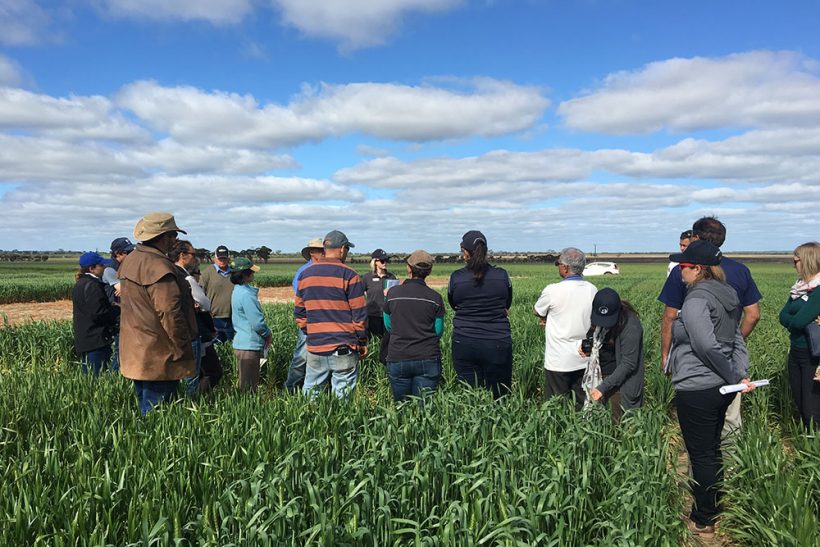JENNY BARTLETT
19 Jun, 2012
A SMALL group of Wheatbelt farmers are taking an innovative approach to research and development (R&D) in WA.
After a decade of dwindling government funded R&D in agriculture, WA growers have struggled to source independent information.
But about 20 farmers from Bruce Rock, Beverley, York and Dowerin have joined forces with the independent grower group, Living Farm.
The group was initially established in 1990 by local York agronomist Bill Roy and was taken over by the Living Farm company in 2008.
Living Farm has continued Mr Roy’s focus of increasing production of broadacre farms through independent, grower funded research.
Living Farm managing director Richard Devlin said the winding down of R&D funding meant traditional bodies like the Department of Agriculture and Food (DAFWA) found it increasingly difficult to conduct and extend on-ground agronomy.
“Without the Department, growers have increasingly struggled to find first-hand, independent and un-biased information,” Mr Devlin said.
He said while many of the grower groups were helping to fill this void, they too were constrained by finances.
“Many of their operating costs are covered by GRDC funded projects, or sponsorship dollars, which means there is generally little, if any, surplus money for grower-driven trials,” Mr Devlin said.
The rise in use of private agronomy companies had also helped to offset the scaling back of DAFWA research, with many growers now relying on their agronomist rather than their local DAFWA representative.
But this too is a cost that is borne by the grower.
“Whichever way you look at it, these days the grower bears the cost of research in their industry,” Mr Devlin said .
“If it’s not through their GRDC levies then it’s through paying a private agronomist who, if they want the latest results, will be paying to get trials conducted.
“This is part of the reason that our Living Farm grower group has remained viable in the face of some tough years.
“Our growers recognised long ago that they are not going to be handed any favours, so took the research into their own hands”
York farmer John Seabrook agreed it was hard to find independent information, especially when the government was ignoring the plight of the industry.
“They have been talking boom times and food shortages for almost 20 years,” Mr Seabrook said.
“But nothing has changed, its frustrating we keep hearing the food shortage term but still no one is investing in the industry.
“The GRDC is good but its research is nation-wide, whereas a local group like Living Farm does trials on local properties, with varieties suitable to the area and provides un-biased information.”
Living Farm differs from other grower groups in that it is entirely funded by members, who decide on the types of trials done by the group.
There were a range of trials conducted each year, with a range of variety, chemical, nutrition and agronomy trials being decided upon each year by the growers.
“The group has been running long enough now that most of the ‘standard’ trials (such as general nutrition and time of sowing) have been conducted,” Mr Devlin said.
As a result growers were now focusing on the latest varieties and chemicals.
One trial that continues to attract a great deal of attention is a long-term rotation trial in York.
According to Living Farm co-ordinator Rebecca Jenkinson, it is one of the longest running rotation plots in WA.
“It is currently in its 18th year and aims to determine the most profitable long-term cropping regime for the Avon Valley,” Ms Jenkinson said.
“Some of the rotations include continuous wheat, a wheat legume rotation and a two wheat break rotation.”
From the different rotations continuous cropping was the clear winner.
Mr Devlin said continuous wheat was by far the most profitable plot, next best was the wheat for three to five years then a legume or pulse break crop.
“We conduct a gross margin analysis on each plot each year, and over the years the continuous wheat rotation is a clear winner, theoretically returning around $8000, while the next best rotation was about $6500,” he said.
One of the worst performing plots was the traditional wheat-lupin rotation.
“This long term trial has confirmed what many Avon Valley growers had already known,” Mr Devlin said.
“That making a profit from a legume is difficult, and that like much of the Wheatbelt finding a profitable break crop is more often miss than hit.”
Mr Devlin said one of the best aspects of the long-term trials was the fact it had now been running for so long, many of the price and yield spikes had largely been ironed out “Often these trials are conducted for three to five years, which is really too short for this sort of project,” he said.
“One or two years of good prices or yields in any given rotation can seriously alter the outcomes of these trials, making the results somewhat biased in favour of certain rotations.
“This trial has been going long enough that the numbers we’re seeing are an excellent representation of what’s happening on a grower scale”


